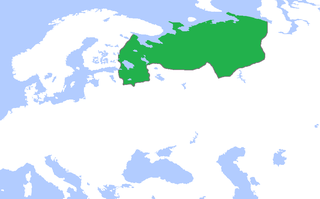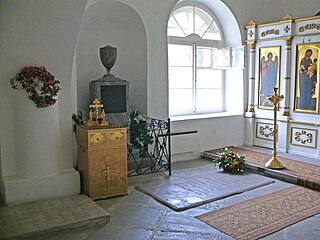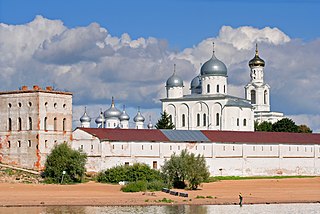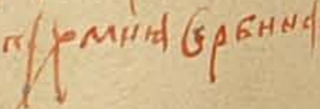
Evfimy II, Archbishop of Novgorod the Great and Pskov from 1429 to 1458, was one of the most prolific patrons of the arts and architecture of all the Novgorodian archbishops.

Evfimy II, Archbishop of Novgorod the Great and Pskov from 1429 to 1458, was one of the most prolific patrons of the arts and architecture of all the Novgorodian archbishops.
According to his saint's lives, Evfimy's baptismal name was Ioann or Ivan and he was the son of a priest Fedor, and his wife, Anna, [1] although some saint's lives give his father's name as Mikheia, and say he was the priest of the Church of St. Fedor the Great Martyr on the Market side of the city (today it is just east of the Aleksandr Nevsky Bridge on the main road running east out of the city.
He was shorn a monk at the Listitsa Hill Monastery (Listitsky) and later transferred to the Vyazhishchsky Monastery 12 miles (7 km) northwest of Novgorod (he is known as Evfimy Viazhishchskii for this reason). He was elected archbishop by the veche after the death of his predecessor Evfimy I (Bradatii) in 1429 but was not consecrated until 1434, and not in Moscow by the Metropolitan of Kiev and All Rus' but in Smolensk, by Geronty, the Metropolitan of Lithuania, [2] an act which angered the Muscovite authorities (although there was no metropolitan in Moscow at the time: Fotii had died in 1431 and Isidor would not arrive until 1437).

Evfimy was one of the greatest cultural patrons builders in Novgorod's history. Much of his cultural patronage looked back on Novgorodian history and his building projects were often reconstructions of old churches on their old foundations and in the old architectural styles. He built or rebuilt more than a dozen churches according to the chronicles, several of which still stand in Novgorod today, including the Church of the Twelve Apostles, The Church of John the Forerunner at Opoky (originally built by Prince Vsevolod Mstislavich in 1127), the Church of the Assumption (also originally built by Vsevolod Mstislavich, the Church of St. George at the Market (again, also originally built by Vsevolod Mstislavich) (the three are right next to one another in the northern part of the Market). He also built a number of secular buildings. The Palace of Facets, built in 1433, still stands northwest of the Cathedral of Holy Wisdom. He also built the belfry to the east of the cathedral and a clocktower west of it. The clocktower collapsed and was rebuilt in 1673.
Evfimy also canonized a number of his predecessors and promoted the veneration of other Novgorodian saints. He discovered the relics of Archbishop Ilya (Ioann) in 1439 and commemorated him as well as 8 other bishops and archbishops who appeared in a vision earlier that year. Legends pertaining to the city in general and the archbishops specifically were compiled under his auspices such as the legends surrounding Archbishop Ilya and others. He brought in Pachomius the Serb to write a number of hagiographic pieces surrounding several Novgorodian saints, many of them Evfimy's predecessors in the archiepiscopal office. Pachomius arrived in Novgorod at the end of the 1430s or beginning of the 1440s, and, under Evfimii's aegis, he composed the Life of Varlaam of Khutyn, the founder of the Khutyn Monastery, as well as the "Tale of the Journey of Ioann (Il'ia, Archbishop of Novgorod 1165-1186) on a Devil to Jerusalem." [3] Pachomius returned to Novgorod and, under the patronage of Archbishop Iona, wrote the Life of Evfimy as well. Thus Evfimy, who did so much to patronize culture, became himself a cultural icon.
Evfimy's archiepiscopate was in some ways one of the high points of the archiepiscopal office in Novgorod. [4] But in spite of this, and in spite of a flourishing of culture, Novgorod suffered a humiliating defeat at the hands of Grand Prince Vasily II in 1456 and signed a severe peace at Iazhelbitsy which limited Novgorod's ability to conduct foreign policy (it required the Grand Prince's approval and could not ally with his enemies).
Evfimy ceased to be active about 1456 (he is not mentioned as part of the peace treaty and did not build churches after 1456 either). It may be that the humiliating defeat affected him personally and he withdrew. He died on March 11, 1458, and was buried in the Viazhishchskii Monastery where he had been a monk.
Evfimy's Life appeared in a mention (monthly books of saint's lives and services) as early as 1494 and he was formally canonized by the Russian Orthodox Church's Moscow Council of 1549. His feast day is March 11 OS/March 24 in the Gregorian Calendar. Upon disinterring his remains, they were said to have been incorrupt. His body now lies in a glass-covered sarcophagus in the Church of St. Evfimy in the Viazhishchskii Monastery after the church was dedicated to him by Metropolitan Aleksei of Leningrad and Novgorod (now Patriarch of Moscow) on March 31, 1990. A new church dedicated to Evfimy and Archbishop Gennady also stands in the cemetery at Kovoleva just east of St. Petersburg.

The Novgorod Republic was a medieval state that existed from the 12th to 15th centuries, stretching from the Gulf of Finland in the west to the northern Ural Mountains in the east, including the city of Novgorod and the Lake Ladoga regions of modern Russia. The Republic prospered as the easternmost trading post of the Hanseatic League, and its Slavic, Baltic and Finnic people were much influenced by the culture of the Viking-Varangians and Byzantine people.

The Cathedral of Holy Wisdom in Veliky Novgorod is the cathedral church of the Metropolitan of Novgorod and the mother church of the Novgorodian Eparchy.

Khutyn Monastery of Saviour's Transfiguration and of St. Varlaam is an Orthodox monastery situated on the right bank of the Volkhov River some 10 km north northeast of Novgorod, in the village of Khutyn. It used to be one of the main Christian shrines of the medieval Novgorod Republic.
The Battle of Shelon was a decisive battle between the forces of the Grand Duchy of Moscow under Ivan III and the army of the Novgorod Republic, which took place on the Shelon River on 14 July 1471. Novgorod suffered a major defeat and ended with the de facto unconditional surrender of the city. Novgorod was absorbed by Muscovy in 1478.
The Treaty of Yazhelbitsy was a peace treaty signed by Vasili II, Grand Prince of Moscow and Vladimir, and the government of Novgorod the Great in the village of Yazhelbitsy in February 1456. This treaty was a significant setback for Novgorod, which would culminate, almost quarter of a century later, in the city being brought under the direct control of the Muscovite Grand Prince in 1478.

Vsevolod Mstislavich Monomakh, the patron saint of the city of Pskov, ruled as Prince of Novgorod in 1117–32, Prince of Pereslavl (1132) and Prince of Pskov in 1137–38.

The St. George's (Yuriev) Monastery is usually cited as Russia's oldest monastery. It stands in 5 kilometers south of Novgorod on the left bank of the Volkhov River near where it flows out of Lake Ilmen. The monastery used to be the most important in the medieval Novgorod Republic. It is part of the World Heritage Site named Historic Monuments of Novgorod and Surroundings.

The Diocese of Novgorod is one of the oldest offices in the Russian Orthodox Church. The medieval archbishops of Novgorod were among the most important figures in medieval Russian history and culture and their successors have continued to play significant roles in Russian history up to the present day. They patronized a significant number of churches in and around the city,, and their artistic and architectural embellishments influenced later Russian art and architecture; they also patronized chronicle-writing, a crucial source on medieval Russian history.
Ioann was Archbishop of Novgorod the Great and Pskov from 1388 until his retirement in 1415. He is not to be confused with Archbishop Ilya, who ruled in the twelfth century, and who is often referred to as Ioann in hagiographic literature but was apparently called Ilya during his archiepiscopate.

The Novgorod Detinets, also known as the Novgorod Kremlin, is a fortified complex (detinets) in Veliky Novgorod, Russia. It stands on the left bank of the Volkhov River about two miles north of where it empties out of Lake Ilmen.

The Trinity Cathedral is located in the Pskov Krom or Kremlin on the east bank of the Velikaya (Great) River. It has, since 1589, been the mother church of the Pskov Eparchy.
Varlaam was Metropolitan of Moscow and All Rus' from 1511 to 1521. He was the seventh Metropolitan in Moscow to be appointed without the approval of the Ecumenical Patriarch of Constantinople as had been the norm.

Pachomius the Serb, also known as Pachomius Logothetes, Russian: Пахомий Логофет, Greek: Παχώμιος Λογοθέτης) was a 15th-century Serbian hagiographer who, after taking monastic vows, was schooled on Mount Athos and mastered the ornate style of medieval Serbian literature. He is credited by the Russian Early Texts Society for the Serbian version of Barlaam and Josaphat from Old Greek.

The Battle of the Novogorodians with the Suzdalians is a twelfth-century episode in which the city of Novgorod the Great was said to have been miraculously delivered from a besieging army from Suzdalia In the fifteenth and sixteenth centuries, the episode became the basis for several hagiographic tales in the Russian church, as well as two large icons executed in the late fifteenth and early sixteenth centuries

The Vyazhishchi Convent of St. Nicholas is an Orthodox convent located in the village of Vyazhishchi, 7 miles (12 km) NNW of Veliky Novgorod. Its surviving buildings date from the period between 1681 and 1708. They are famous for having the richest maiolica decorations in Northwest Russia.
Serapion was Archbishop of Novgorod the Great and Pskov from 1506 to 1509. He is a saint of the Russian Orthodox Church; his feast day is March 16 by the Julian calendar.

Novgorodian Land was one of the largest historical territorial–state formations in Russia, covering its northwest and north. Novgorod Land, centered in Veliky Novgorod, was in the cradle of Kievan Rus' under the rule of the Rurikovich dynasty and one of the most important princely thrones of the era. During the collapse of Kievan Rus' and in subsequent centuries, Novgorod Land developed as the Novgorod Republic: an autonomous state with republican forms of government under the suzerainty of the great princes of Vladimir-Suzdal. During the period of greatest development, it reached north to the White Sea, and in the east it spread beyond the Ural Mountains. It had extensive trade relations within the framework of the Hanseatic League and with the rest of Rus'. Muscovy conquered the Novgorod Republic in 1478, and annexed it in 1578, although Novgorod Land continued to exist as an administrative unit until 1708.

Ilya of Novgorod, also known as Ioann (John) of Novgorod, was Archbishop of Novgorod from 1165 to his death in 1186.